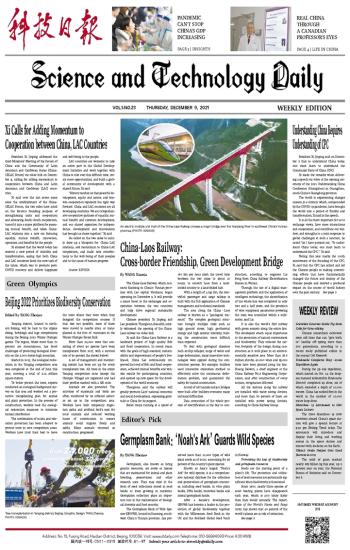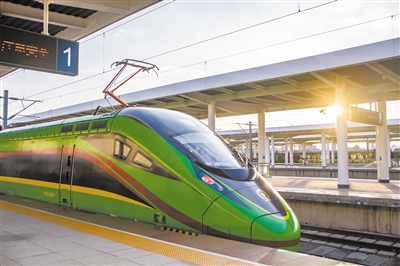
 Real China through a Canadian Professor's Eyes
Real China through a Canadian Professor's Eyes Pandemic Can't Stop China's GDP Increasing
Pandemic Can't Stop China's GDP Increasing Xi Calls for Adding Momentum to Cooperation between China, LAC Countries
Xi Calls for Adding Momentum to Cooperation between China, LAC Countries China-Laos Railway: Cross-border Friendship, Green Development Bridge
China-Laos Railway: Cross-border Friendship, Green Development Bridge Understanding China Requires Understanding of CPC
Understanding China Requires Understanding of CPC Beijing 2022 Prioritizes Biodiversity Conservation
Beijing 2022 Prioritizes Biodiversity Conservation WEEKLY REVIEW
WEEKLY REVIEW Germplasm Bank: ‘Noah's Ark’ Guards Wild Species
Germplasm Bank: ‘Noah's Ark’ Guards Wild Species
 |
| An electric multiple unit train of the China-Laos Railway crosses a major bridge over the Yuanjiang River in southwest China's Yunnan province. (PHOTO: XINHUA) |
 |
The China-Laos Railway, which connects Kunming in China's Yunnan province with Lao capital Vientiane, began operating on December 3. It will provide a major boost to the exchanges and cooperation between the two countries and help drive regional sustainable development.
Chinese president Xi Jinping and Lao president Thongloun Sisoulith jointly witnessed the opening of the China-Laos railway via video link.
Xi said the China-Laos Railway is a landmark project of high-quality Belt and Road cooperation. In recent years, with the goals of high standard, sustainability and improvement of people's livelihood, China has continuously improved the level of Belt and Road cooperation, achieved mutual benefits and win-win results for participating countries, and opened up new space for the development of the world economy.
Thongloun said the railway will greatly promote Laos' national economic and social development, expressing gratitude to China for its support.
Bullet trains running at a speed of 160 km per hour slash the travel time between the two cities to about 10 hours, to convert Laos from a landlocked country to a land-linked hub.
With a length of 1,035 km, the electrified passenger and cargo railway is built with the full application of Chinese management and technical standards.
The area along the China -Laos railway is known as a "geological museum". The complex geological structure brought multiple risks such as high ground stress, high geothermal energy and high seismic intensity, making the construction more difficult than expected.
To deal with geological disasters such as slip collapse, surge of water and large deformation, many innovative technologies were applied during the construction process. For example, builders used innovative excavation method to effectively solve the continuous deformation problem, and guaranteed the safety for tunnel construction.
A total of 167 tunnels and 301 bridges were built after builders overcame many technical difficulties.
Data connection of the whole process of electrification is the key to construction, according to engineer Lai Peng from China Railway Electrification Bureau in Wuhan.
Through the use of a digital management platform and the application of intelligent technology, the electrification of the whole line was completed in only two and a half years, and the precision of wire equipment parameters powering the train was controlled within a millimeter, said Lai.
It is also the world's first railway with green scenery along the entire line. The developers attach equal importance to the protection of natural environment and biodiversity. They reduced the carbon footprint of the design during construction as it took place in an environmentally sensitive area. More than 28.6 million shrubs, 40,000 vines and 63,000 trees have been planted along the line. Huang Daiwen, a chief engineer at the China Railway No.2 Engineering Corporation, said after construction of every section, revegetation followed.
All the stations along the railway are installed with water saving devices, and more than 80 percent of them are installed with power saving devices, according to China Railway Group.

 Next
Next



